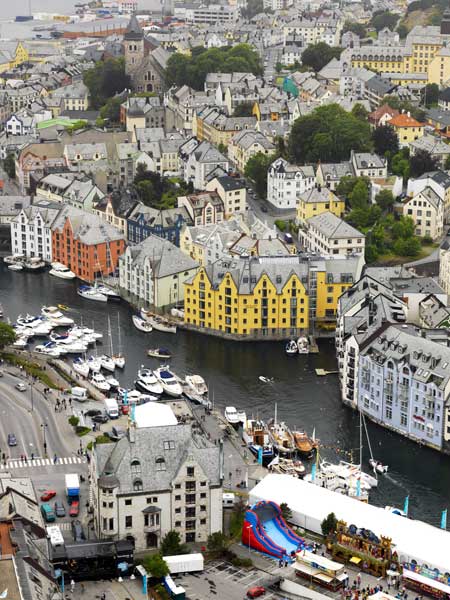Trail of the Unexpected: Alesund, the Nouveau city that rose from the ashes
Fire devastated Alesund; now it is a Norwegian architectural icon, says Siobhan Mulholland

The Norwegians love their sayings. Many, understandably, involve the climate ("There is no such thing as bad weather, only bad clothing"). Another incorporates local wildlife for a Nordic take on counting chickens and hatching: "Don't sell the fur before you've shot the bear". And some are influenced by significant events in the nation's history, notably: "I haven't seen anything like it since Alesund burned down."
Alesund is a port on a peninsula, way up on the north-west coast of Norway. Today, thanks to North Sea oil earnings, it is accessible through an elegant network of bridges and tunnels. But one cold January night in 1904, it was devoured by fire, with the loss of 850 houses. Phoenix-like, the town rose from the ashes in just three years, built in the Jugendstil style (the German take on Art Nouveau).
Every other town along the coast comprises wooden clapboard houses in terracotta, mustard and white. But at Alesund, you find pastel-painted fronts, turrets, spires and gargoyles. Everything is in stone to withstand future fires, and all is in moderation – nothing too extravagant in this nation of Lutheran conformity. The history of this fascinating recreation is captured in the Jugendstilsenteret, a former pharmacy which is now the town's Art Nouveau Centre.
This is a part of the world so fabulously people-free that, when I first wandered through the town on a summer afternoon, it was empty. It was as if the major visitor attractions had opened their doors just for me: the big and impressive Aquarium on the edge of the town; the Art Museum KUBE; and Aalesunds Museum in the centre of town with its collection of Second World War artefacts.
The sense of solitude continued in the evenings, sitting at the harbourside bar of the Radisson Blu Hotel where I was staying, eking out £7 glasses of wine. (For most of Norway, assume UK prices to be doubled – but on the north-west coast, from Bergen upwards, triple everything to avert any surprises.)
The water was eerily still, the light spookily bright at 10pm and the quietness chilling. A small congregation of people sat out on the deck, their hushed voices awed by Norway's great outdoors: an archipelago of islands stretching out to the Norwegian Sea, the Sunnmore mountains behind them and the never-ending sky above.
For a high-definition view of this climb, take the 418 steps from the town to the top of Mount Aksla. On a clear day it will give you an idea of the scale and scope of this stunning peninsula.
All the cruise ships heading to the fjords of western Norway stop at Alesund before turning towards these natural wonders. But to reach Geirangerfjord I took the local bus, or at least the coastal ferry. This is the Hurtigruten ("coastal express"), which began life 120 years ago taking passengers, goods and mail to communities along the extensive Norwegian coast. They have now evolved into something approaching cruise ships, with swimming pools, luxury suites and a choice of restaurants.
The day I sailed through the fjords, the sun shone and the deck was packed with sightseers trying to capture the detail of a three-dimensional geological marvel in two dimensions. Depending which side of the ship the geological wonder appeared on, my fellow passengers would run to port or starboard, clicking away. It was musical chairs – except in this game people sat down only when sated by the view.
You have to sail below those mountains to appreciate the power of ice to carve through rock, and look down into the water to contemplate the dark and very cold depths.
The conclusion of this mysterious and magical tour is the town of Geiranger. Surrounded by an arc of mountains, it has the impressive Norwegian Fjord Centre that tells tales of people and communities on one of the world's rawest edges. It gives life to the picturesque abandoned farms that still cling to the mountainsides – and offers glimpses into what life was like, with children being tethered to posts and rocks to prevent them from falling into the water below.
When I returned to Alesund, it was (inevitably) still light, but the mist had come in. The vibrant colours of earlier were muted – everything looked grey. Needless to say, the Norwegians have a saying for this: "All weather is passing". Yet in a country, and especially a region, of such elemental beauty, it's easy to forgive the weather and the prices; you're too distracted by the ocean, the mountains – and, in Alesund, the architecture – to notice for long.
Getting there
* The author travelled with Inghams (020-8780 4454; inghams.co.uk), which offers three nights at the Radisson Blu in Alesund for £539, including flights from Heathrow on SAS (0871 521 2772; flysas.com) via Oslo, transfers and breakfast.
* Inghams also offers a range of pre-bookable excursions such as trips to the Ona Fishing Hamlet for £59.
Visiting there
* 62 Degrees North (00 47 70 11 44 30; 62nord.net) organises the "Fjord Experience". The trip from Alesund to Geirangerfjord costs 890 kroner (£90). *Hotel Union, Geiranger: 00 47 70 26 83 00; hotel-union.no.
More information
Innovation Norway: visitnorway.co.uk
Join our commenting forum
Join thought-provoking conversations, follow other Independent readers and see their replies
Comments